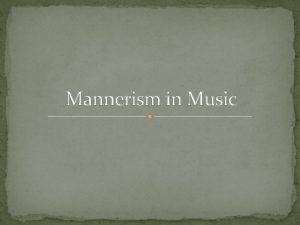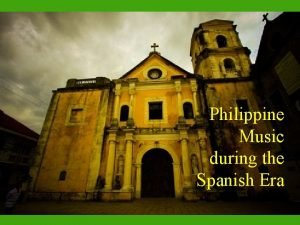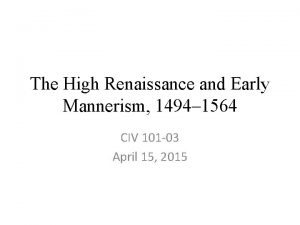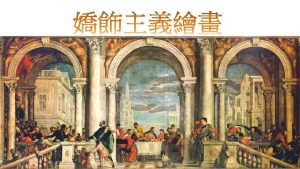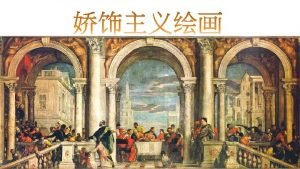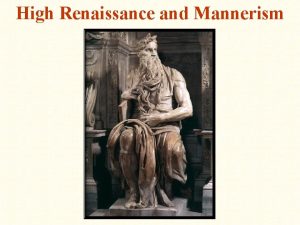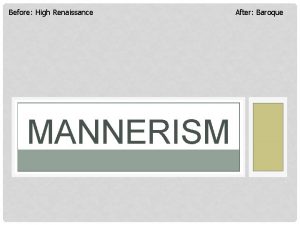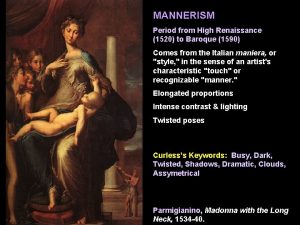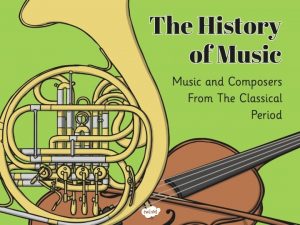Mannerism in Music Music during the Manneristic period









- Slides: 9

Mannerism in Music

Music during the Manneristic period shows few of the peculiarities and even artificialities which have been noted in the field of fine arts. The Italians al last had enough of the complicated Flemish polyphony. It was, however, ideally suited to the new spirit of devotion and spirituality which pervaded the church as a result of the Counter Reformation.

Palestrina, Victoria, and Lassus

Palestrina, Victoria and Lassus are the masses and motets of the Italian Palestrina (c. 1525 -1594) and his Spanish friend Victoria (c. 1540 -1611) in their ardent passion and dramatic expressiveness, represent the ideal music of the Catholic faith. Musician often link Lassus and Palestrina because they were contemporary (both died in 1594), and both composed the purest of a cappella church music. Stylistically the are similar in their mixture of polyphony and homophony and their use of the old church scales but with an increase feeling for major and minor tonality.

Lassus remained the true man of Renaissance, the hearty Fleming at home in every musical form of the period. Palestrina and the younger Victoria were Jesuits-inspired, writing a lofty purity. It is their mood of excessive awe and sublimity that links them with the Mannerist period.

Luca Marenzio "Marentio" The composer who completed this development was Marenzio (c. 1560 -1599). In his music all the resources of the polyphony and homophony are made to serve the poetic text. In order to paint in music the dramatic word pictures of the text he deliberately turned his back on the old church scales in favor of modern tonality.

Zarlino and the development of harmony Before the resources of modern harmony, based on the interrelationship of keys, could be fully exploited. This was whether to tune the keyboard instrument by mathematics or by ear. If the classical Greek influence had been less strong, it would probably have been settled sooner. The ear tuning, or equal temperament as it came to be called, was finally established by Zarlino, a Venetian theorist (1558)

He calls the four -voice setting the normal one, and he likens the four voices to the four elements. Bass – Earth (Foundation of the harmony) Tenor – Water Alto – Air Soprano – Fire Soprano is the most important part because of its ornamental and elegant cantilena, proceeding such a manner that it nourishes and feeds the souls of those who listen.

Opera and Oratorio one of the first practical applications of Zarlino’s ideas was in the opera and oratorio which were born in the same year 1600. there had been throughout the fifteenth and sixteenth centuries societies called “academies” where groups of artistic dilletantes gathered to discuss art and enjoy social good time. One of these, called “Camerata” met in the home of Count Bardi in Florence.
 Mannerism in music
Mannerism in music Examples of tagalog zarzuela
Examples of tagalog zarzuela Prince of philippines church music
Prince of philippines church music What are mannerism characteristics
What are mannerism characteristics Mannerism
Mannerism Music music music
Music music music During the later vedic period chamberlain was known as
During the later vedic period chamberlain was known as Why had farming become unprofitable during this period
Why had farming become unprofitable during this period How to know if pms or pregnant
How to know if pms or pregnant Why had farming become unprofitable during this period?
Why had farming become unprofitable during this period?
